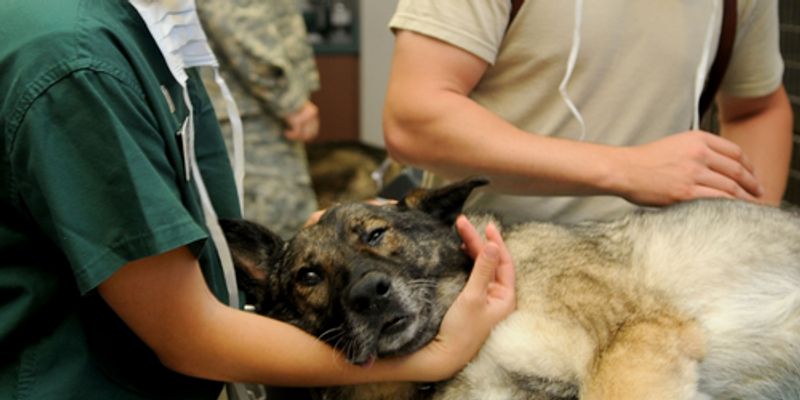Veterinary medicine and surgery
Verterinary medicne is a branch of medicine related to treating animals with a variety of health conditions including preventation, management, diagnosis, and treatment of diseases and/or injury. Veterinary surgery specifically deals with procedures to treat a variety of conditions.
-
FEB 24, 2022 | 9:00 AMDate: February 24, 2021 Time: 9:00am (PST), 12:00pm (EST) Cytokine profiling is a valuable tool used in preclinical research for monitoring an immune response and cell signaling pathways dur...MAY 11, 2021 | 10:00 AMDate: May 11, 2021 Time: 10:00zm PDT Your samples are some of the most valuable assets in the laboratory. After spending countless hours on extraction and preparation, your conclusions could...Speaker: Paulina Kocjan , Kate Meola , Zareh ZurabyanFEB 10, 2021 | 9:00 AMThe concept of the 3Rs remains more prevalent than ever in global discussions related to humane animal use in aspects of research, teaching and testing. The 3Rs serve as a touchstone, in ter...Speaker: F. Claire Hankenson, DVM, MS, DACLAMPresented at: Laboratory Animal Sciences Virtual Event Series 2021
FEB 10, 2021 | 12:00 AMPrimates have been essential in unlocking novel immune mechanisms that have driven development of groundbreaking new drugs in infectious disease and transplantation, amongst others related t...Speaker: Melanie L. Graham, MPH, PhDPresented at: Laboratory Animal Sciences Virtual Event Series 2021
FEB 10, 2021 | 12:00 AMLearning Objectives: 1. Methods on how to aseptically use foil (Reynolds Wrap) in rodent surgery 2. Methods on how aseptically use cling film (Press N' Seal) in rodent surgery 3. Long-te...Speaker: Raphael A. Malbrue, DVM, MS, CertAqVPresented at: Laboratory Animal Sciences Virtual Event Series 2021
MAY 14, 2020 | 12:00 AMThe ability to rapidly and accurately identify pain in mice is critical for providing them optimal care and welfare. To meet this need, we developed and validated the Grooming Transfer Test...Speaker: Jennifer Lofgren, DVM, MS, DACLAMPresented at: Laboratory Animal Sciences Virtual Event Series 2020
JAN 30, 2020 | 9:00 AMDATE: January 30, 2020 TIME: 9:00am PST, 12:00pm EST Recent advances in in vitro 3D cellular culture technologies, such as organoids, rapidly developed and established novel, more physiologi...SEP 12, 2019 | 8:00 AMDATE: September 12, 2019TIME: 8:00am PDTIn the upcoming era of personalized medicine, there is a growing need for the development of rapid, sensitive, precise and accurate analysis of t...FEB 27, 2019 | 12:00 PMToo frequently the investigator will provide “scientific” reasons to justify precluding analgesics from experimental procedures that may involve more than momentary pain, often wi...FEB 14, 2019 | 7:30 AMComparative oncology is the study of naturally-occurring cancers in pet animals (mainly dogs) to broaden and deepen our collective understanding of cancers in both companion species and human...Speaker: Amy LeBlanc, DVM DACVIMPresented at: Laboratory Animal Sciences Virtual Event Series 2019
JUN 21, 2018 | 7:30 AMCrohn’s disease and ulcerative colitis also known as inflammatory bowel diseases or IBD, are characterized by chronic, recurrent inflammation of the gastrointestinal tract, which result...FEB 07, 2018 | 10:30 AMThe ability to rapidly and accurately identify pain in mice is critical for providing them optimal care and welfare. To meet this need, we developed and validated the Grooming Transfer Test (...Speaker: Jennifer Lofgren, DVM, MS, DACLAMPresented at: Laboratory Animal Sciences Virtual Event Series 2018
FEB 08, 2017 | 1:30 PMDATE: February 8, 2017TIME: 1:30pm PT, 4:30pm ETIn rabbits, buprenorphine instant release (IR) is commonly used to alleviate pain, especially in surgical models. However, maintenan...Speaker: Andrea Zanetti, DVM, PhD, SRSPresented at: Laboratory Animal Sciences Virtual Event Series 2017
FEB 08, 2017 | 7:30 AMDATE: February 8, 2017TIME: 7:30am PT, 10:30am ETMany of us who believe in the importance of aseptic rodent surgery have lived through the frustration of trying to implement rodent asep...Speaker: Marcel Perret-Gentil, DVM, MSPresented at: Laboratory Animal Sciences Virtual Event Series 2017
FEB 04, 2016 | 12:00 PMWorking with animals carries legal, scientific and ethical responsibilities. These responsibilities merge as we strive to humanely use the least number of animals necessary to provide t...Speaker: Marilyn Brown, DVM MS ACLAM ECLAMPresented at: Laboratory Animal Sciences Virtual Event Series 2016
FEB 03, 2016 | 12:00 PMThe use of laboratory animals requires education and training of persons who are to design and/or perform animal experiments. It is essential for these persons to practice various procedures...Speaker: Klas Abelson, PhD , Jeffrey Everitt, DVMPresented at: Laboratory Animal Sciences Virtual Event Series 2016
FEB 05, 2015 | 3:00 PMC.E. CREDITSAs evidenced by the changes in the new Guide for the Care and Use of Laboratory animals and the latest AVMA Panel on Euthanasia, it is clear that there is growing concern about the care and w...FEB 05, 2015 | 10:30 AMC.E. CREDITSIn the context of an experimental project requiring surgical preparation of animals, training is not only required for technicians lacking a strong surgical background but also for more exper...Speaker: Delphine Bouard DVM, Dip Vet LASPresented at: Laboratory Animal Sciences Virtual Event Series 2015
FEB 05, 2015 | 7:30 AMC.E. CREDITSAn anesthesia system designed to accommodate the physiological characteristics of small animals, including rats and mice, has the potential to provide great practical value to the life scienc...FEB 04, 2015 | 1:30 PMC.E. CREDITSThe field of surgical research has been growing rapidly with the development of new surgical and disease models. An extremely important and often overlooked aspect of creating these models is...Speaker: Szczepan Baran, VMD, MSPresented at: Laboratory Animal Sciences Virtual Event Series 2015
FEB 04, 2015 | 10:30 AMC.E. CREDITSIt is the often-ignored simple tips in rodent surgery that make the difference and help minimize postoperative complications and mortality. The presenter will use his years of experience to...Speaker: Marcel Perret-Gentil, DVM, MSPresented at: Laboratory Animal Sciences Virtual Event Series 2015
FEB 06, 2014 | 10:00 AMThe proper surgical techniques represent a key opportunity to improve the welfare of laboratory rodents, while meeting legal and ethical obligations. Use of inappropriate or poor surgical tec...Speaker: Szczepan Baran, VMD, MSPresented at: Laboratory Animal Sciences Virtual Event Series 2014
FEB 06, 2014 | 9:00 AMThe 2011 Guide for the Care and Use of Laboratory Animals has required that institutions place importance on assuring that staff working with animals are trained and competent to perform thei...Speaker: Mary Ann Vasbinder, DVM, ACLAM and Asheley Wathen, DVM, MPH, DACLAMPresented at: Laboratory Animal Sciences Virtual Event Series 2014
FEB 05, 2014 | 10:00 AMGOAL:"A simple and reliable method for mouse intubation" is designed as an instructional tutorial with learning objectives that are twofold. First is becoming familiar with the procedure an...Speaker: Jennifer K. Hendrick, BS, LATgPresented at: Laboratory Animal Sciences Virtual Event Series 2014
FEB 24, 2022 | 9:00 AM
Date: February 24, 2021 Time: 9:00am (PST), 12:00pm (EST) Cytokine profiling is a valuable tool used in preclinical research for monitoring an immune response and cell signaling pathways dur...
MAY 11, 2021 | 10:00 AM
Date: May 11, 2021 Time: 10:00zm PDT Your samples are some of the most valuable assets in the laboratory. After spending countless hours on extraction and preparation, your conclusions could...
Speaker:
Paulina Kocjan
, Kate Meola
, Zareh Zurabyan
FEB 10, 2021 | 9:00 AM
The concept of the 3Rs remains more prevalent than ever in global discussions related to humane animal use in aspects of research, teaching and testing. The 3Rs serve as a touchstone, in ter...
Speaker:
F. Claire Hankenson, DVM, MS, DACLAM
Presented at: Laboratory Animal Sciences Virtual Event Series 2021
FEB 10, 2021 | 12:00 AM
Primates have been essential in unlocking novel immune mechanisms that have driven development of groundbreaking new drugs in infectious disease and transplantation, amongst others related t...
Speaker:
Melanie L. Graham, MPH, PhD
Presented at: Laboratory Animal Sciences Virtual Event Series 2021
FEB 10, 2021 | 12:00 AM
Learning Objectives: 1. Methods on how to aseptically use foil (Reynolds Wrap) in rodent surgery 2. Methods on how aseptically use cling film (Press N' Seal) in rodent surgery 3. Long-te...
Speaker:
Raphael A. Malbrue, DVM, MS, CertAqV
Presented at: Laboratory Animal Sciences Virtual Event Series 2021
MAY 14, 2020 | 12:00 AM
The ability to rapidly and accurately identify pain in mice is critical for providing them optimal care and welfare. To meet this need, we developed and validated the Grooming Transfer Test...
Speaker:
Jennifer Lofgren, DVM, MS, DACLAM
Presented at: Laboratory Animal Sciences Virtual Event Series 2020
JAN 30, 2020 | 9:00 AM
DATE: January 30, 2020 TIME: 9:00am PST, 12:00pm EST Recent advances in in vitro 3D cellular culture technologies, such as organoids, rapidly developed and established novel, more physiologi...
SEP 12, 2019 | 8:00 AM
DATE: September 12, 2019TIME: 8:00am PDTIn the upcoming era of personalized medicine, there is a growing need for the development of rapid, sensitive, precise and accurate analysis of t...
FEB 27, 2019 | 12:00 PM
Too frequently the investigator will provide “scientific” reasons to justify precluding analgesics from experimental procedures that may involve more than momentary pain, often wi...
FEB 14, 2019 | 7:30 AM
Comparative oncology is the study of naturally-occurring cancers in pet animals (mainly dogs) to broaden and deepen our collective understanding of cancers in both companion species and human...
Speaker:
Amy LeBlanc, DVM DACVIM
Presented at: Laboratory Animal Sciences Virtual Event Series 2019
JUN 21, 2018 | 7:30 AM
Crohn’s disease and ulcerative colitis also known as inflammatory bowel diseases or IBD, are characterized by chronic, recurrent inflammation of the gastrointestinal tract, which result...
FEB 07, 2018 | 10:30 AM
The ability to rapidly and accurately identify pain in mice is critical for providing them optimal care and welfare. To meet this need, we developed and validated the Grooming Transfer Test (...
Speaker:
Jennifer Lofgren, DVM, MS, DACLAM
Presented at: Laboratory Animal Sciences Virtual Event Series 2018
FEB 08, 2017 | 1:30 PM
DATE: February 8, 2017TIME: 1:30pm PT, 4:30pm ETIn rabbits, buprenorphine instant release (IR) is commonly used to alleviate pain, especially in surgical models. However, maintenan...
Speaker:
Andrea Zanetti, DVM, PhD, SRS
Presented at: Laboratory Animal Sciences Virtual Event Series 2017
FEB 08, 2017 | 7:30 AM
DATE: February 8, 2017TIME: 7:30am PT, 10:30am ETMany of us who believe in the importance of aseptic rodent surgery have lived through the frustration of trying to implement rodent asep...
Speaker:
Marcel Perret-Gentil, DVM, MS
Presented at: Laboratory Animal Sciences Virtual Event Series 2017
FEB 04, 2016 | 12:00 PM
Working with animals carries legal, scientific and ethical responsibilities. These responsibilities merge as we strive to humanely use the least number of animals necessary to provide t...
Speaker:
Marilyn Brown, DVM MS ACLAM ECLAM
Presented at: Laboratory Animal Sciences Virtual Event Series 2016
FEB 03, 2016 | 12:00 PM
The use of laboratory animals requires education and training of persons who are to design and/or perform animal experiments. It is essential for these persons to practice various procedures...
Speaker:
Klas Abelson, PhD
, Jeffrey Everitt, DVM
Presented at: Laboratory Animal Sciences Virtual Event Series 2016
FEB 05, 2015 | 3:00 PM
C.E. CREDITS
As evidenced by the changes in the new Guide for the Care and Use of Laboratory animals and the latest AVMA Panel on Euthanasia, it is clear that there is growing concern about the care and w...
FEB 05, 2015 | 10:30 AM
C.E. CREDITS
In the context of an experimental project requiring surgical preparation of animals, training is not only required for technicians lacking a strong surgical background but also for more exper...
Speaker:
Delphine Bouard DVM, Dip Vet LAS
Presented at: Laboratory Animal Sciences Virtual Event Series 2015
FEB 05, 2015 | 7:30 AM
C.E. CREDITS
An anesthesia system designed to accommodate the physiological characteristics of small animals, including rats and mice, has the potential to provide great practical value to the life scienc...
FEB 04, 2015 | 1:30 PM
C.E. CREDITS
The field of surgical research has been growing rapidly with the development of new surgical and disease models. An extremely important and often overlooked aspect of creating these models is...
Speaker:
Szczepan Baran, VMD, MS
Presented at: Laboratory Animal Sciences Virtual Event Series 2015
FEB 04, 2015 | 10:30 AM
C.E. CREDITS
It is the often-ignored simple tips in rodent surgery that make the difference and help minimize postoperative complications and mortality. The presenter will use his years of experience to...
Speaker:
Marcel Perret-Gentil, DVM, MS
Presented at: Laboratory Animal Sciences Virtual Event Series 2015
FEB 06, 2014 | 10:00 AM
The proper surgical techniques represent a key opportunity to improve the welfare of laboratory rodents, while meeting legal and ethical obligations. Use of inappropriate or poor surgical tec...
Speaker:
Szczepan Baran, VMD, MS
Presented at: Laboratory Animal Sciences Virtual Event Series 2014
FEB 06, 2014 | 9:00 AM
The 2011 Guide for the Care and Use of Laboratory Animals has required that institutions place importance on assuring that staff working with animals are trained and competent to perform thei...
Speaker:
Mary Ann Vasbinder, DVM, ACLAM and Asheley Wathen, DVM, MPH, DACLAM
Presented at: Laboratory Animal Sciences Virtual Event Series 2014
FEB 05, 2014 | 10:00 AM
GOAL:"A simple and reliable method for mouse intubation" is designed as an instructional tutorial with learning objectives that are twofold. First is becoming familiar with the procedure an...
Speaker:
Jennifer K. Hendrick, BS, LATg
Presented at: Laboratory Animal Sciences Virtual Event Series 2014






















